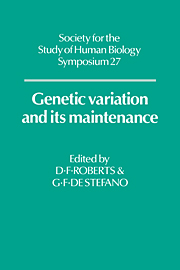Book contents
- Frontmatter
- Contents
- Preface
- Part I Genetic Diversity - Its Dimensions
- Genetic polymorphisms - a widening panorama
- Some implications of improved electrophoresis techniques for population genetics
- HLA variation in the tropics
- Chromosome polymorphism in humans
- Restriction fragment length polymorphisms in the human genome
- Nucleotide sequences, restriction maps, and human mitochondrial DNA diversity
- Mitochondrial DNA variation in eastern highlanders of Papua New Guinea
- The Contribution of polymorphisms in mtDNA to population genetic studies
- Part II Genetic Diversity - Its Origin and Maintenance
- GENETIC DIVERSITY - APPLICATIONS AND PROBLEMS OF COMPLEX CHARACTERS
- Index
Genetic polymorphisms - a widening panorama
Published online by Cambridge University Press: 05 March 2012
- Frontmatter
- Contents
- Preface
- Part I Genetic Diversity - Its Dimensions
- Genetic polymorphisms - a widening panorama
- Some implications of improved electrophoresis techniques for population genetics
- HLA variation in the tropics
- Chromosome polymorphism in humans
- Restriction fragment length polymorphisms in the human genome
- Nucleotide sequences, restriction maps, and human mitochondrial DNA diversity
- Mitochondrial DNA variation in eastern highlanders of Papua New Guinea
- The Contribution of polymorphisms in mtDNA to population genetic studies
- Part II Genetic Diversity - Its Origin and Maintenance
- GENETIC DIVERSITY - APPLICATIONS AND PROBLEMS OF COMPLEX CHARACTERS
- Index
Summary
INTRODUCTION
Sir Christopher Wren in 1657 was the first to make intravenous therapy possible, in that he devised an instrument - a needle made from a slender quill fixed to a bladder - by which substances could be injected. As a result, over the next two and a half centuries the sequelae that often followed transfusions came to be recognised, and were documented especially during the Franco-German war when many attempts were made to help the wounded by transfusion under field conditions. But it was the discovery (1875) of serological species specificity, in that mixture of red blood cells of an animal of one species with serum from one of another in vitro leads to agglutination of the red cells, that triggered the discovery of the first blood polymorphism in man. For it was this that prompted Landsteiner to enquire whether differences in agglutination, similar to those in interspecific mixtures, occurred between individuals of the same species.
SYSTEMS
Red cell blood groups
The simplest method of investigation, mixing the serum of one person with the red blood cells of another, led Landsteiner to discover what subsequently became known as the A, B and O blood groups in 1900. The fourth (AB) group was discovered two years later. Then at first there was little advance. In 1910 the Mendelian inheritance of the ABO system was established, and in the same year the A1-A2 subdivisions were discovered by von Dungern and Hirszfeld. That the frequencies differed from one population to another was established by the Hirszfelds' examination of soldiers and prisoners of war of different nationalities.
- Type
- Chapter
- Information
- Genetic Variation and its Maintenance , pp. 1 - 10Publisher: Cambridge University PressPrint publication year: 1986



